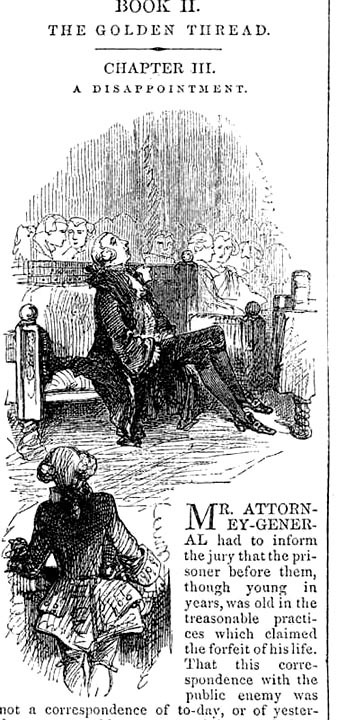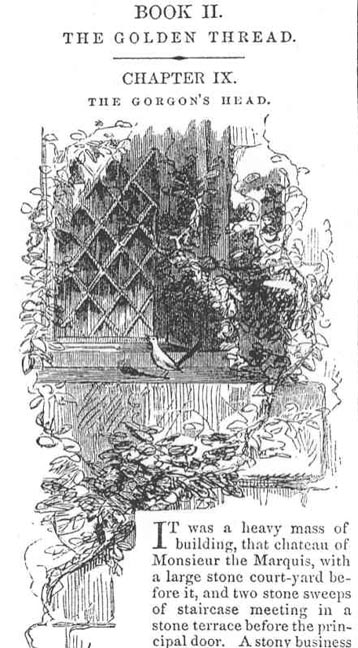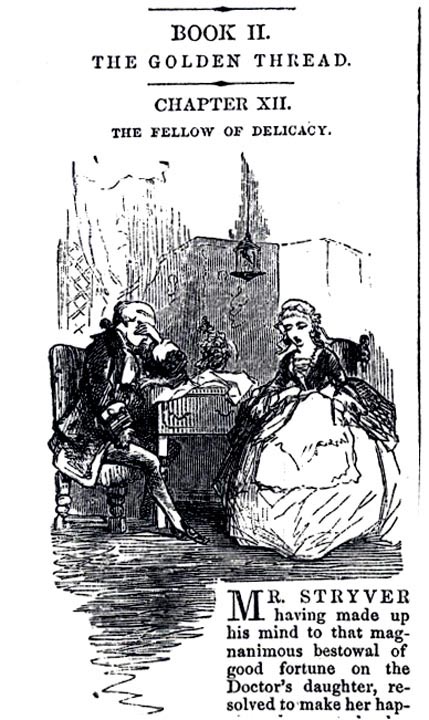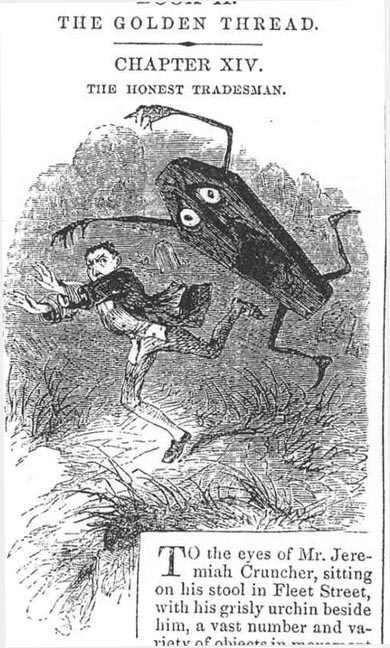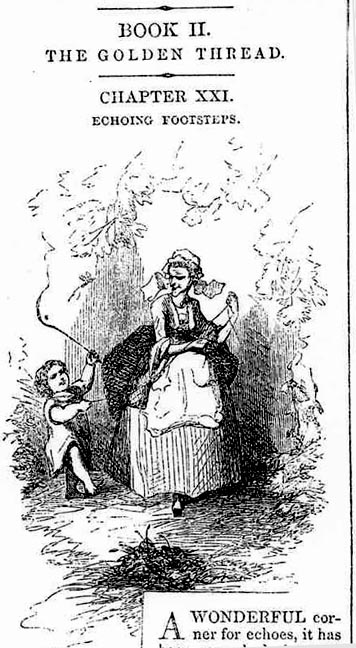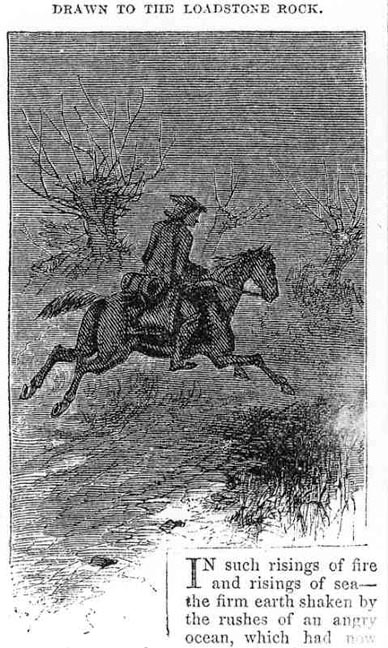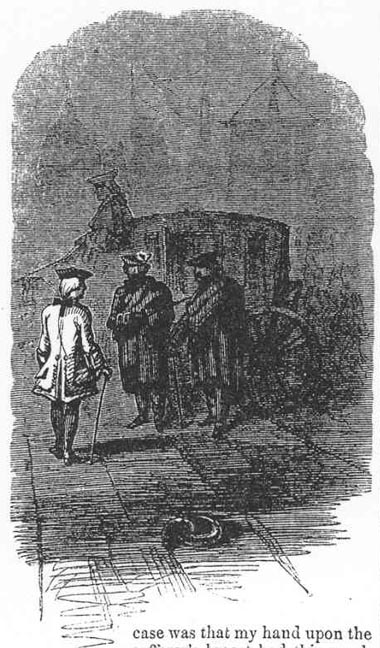John McLenan's Thirty-One Headnote Vignettes for A Tale of Two Cities in Harper's Weekly (7 May — 3 December 1859)

The initial vignette for Great Expectations, 24 November 1860: The alternative to Australian transportation for habitual criminals.
The small-scale headnote-vignettes that precede each weekly instalment of a serialised novel such as Dickens's A Tale of Two Cities (McLenan, 7 May-26 November 1859) or Wilkie Collins's No Name (McLenan, 15 March 1862-17 January 1863) are a distinctive paratextual feature of Harper's Weekly: A Journal of Civilization. Like its transAtlantic counterparts, the large-scale British weeklies The Illustrated London News (founded in 1842) and later The Graphic (founded in 1869), Harper's Weekly from 1857 covered recent news events, including political affairs and the theatres, and of course throughout the early to mid-1860s the Civil War in text and large-scale illustrations. And, like its British counterparts, it ran contemporary short fiction and novels in serial accompanied by woodblock illustrations. However, the American weekly had a distinctive visual component: the uncaptioned headnote vignette, which led off each week's number of a work in serial.
Typically, a weekly vignette is 11.3 cm high by 5.5 cm wide (5 ⅝ by 2 ¾ inches), and includes the magazine's signature: the date of issue, the statement of copyright protection, the title of the novel, the name of the author, "Printed from the Author's Manuscript. Richly illustrated," and then the chapter number, and proceeded by (if applicable) the title of the part.
The vignette, despite its lacking a caption to guide the reader to the moment realised, may be read proleptically, that is, it offers clues in its detailing, its background, and in its principal figure, as to the textual passage whose importance it underscores by its commanding position at the head of the number. Accordingly, it both previews and foreshadows a significant moment in the week's instalment. Upon seeing it for the first time, the serial reader must have instantly experienced a sense of anticipation, realizing that this a visualisation of an important moment in the text. It does not necessarily realise a moment at the beginning of the number; sometimes that moment lies well ahead, and therefore encouraged a more intense engagement with the letterpress. Frequently, upon discovering the passage realised, the reader would turn back to re-examine the miniature illustration. Necessarily, because the background must be minimal in so small a wood-engraving, the illustrator tends to focus on a single figure, but provides details such as properties and clothing to direct the reader to the point anticipated.
The serial vignettes appear here courtesy of the E. J. Pratt Fine Arts Library, University of Toronto; the Irving K. Barber Learning Centre, University of British Columbia, Vancouver, Canada; and the McPherson Library's Special Collections, at the University of Victoria, British Columbia.
Related Materials
Illustrated Editions (1859-1910)
- Hablot K. Brown or 'Phiz' (16 illustrations)
- John McLenan (more than 60 illustrations and decorations)
- Sol Eytinge, Junior (8 illustrations)
- Fred Barnard (25 illustrations)
- A. A. Dixon (12 illustrations)
- Harry Furniss (32 illustrations)
Related Material
- Hablot Knight Browne's (Phiz's) Monthly Serial Illustrations (June-December 1859)
- McLenan's and Phiz's Illustrations for
A Tale of Two Cities (1859): A Correspondence?
- Images of the French Revolution from Various Editions of A Tale of Two Cities (1859-1910)
- Illustrations by Sol Eytinge, Jr., for The Diamond Edition (1867)
- Fred Barnard's Twenty-five Household Edition Illustrations (1874)
- A. A. Dixon's Illustrations for The Collins Pocket Edition (1905)
- Illustrations by Harry Furniss for The Charles Dickens Library Edition (1910)
Scanned images and text by Philip V. Allingham. [You may use these images without prior permission for any scholarly or educational purpose as long as you (1) credit the person who scanned the images and (2) link your document to this URL in a web document or cite the Victorian Web in a print one.]
Bibliography
Allingham, Philip V. "'Charles Dickens's A Tale of Two Cities (1859) Illustrated: A Critical Reassessment of Hablot Knight Browne's Accompanying Plates." Dickens Studies. 33 (2003): 109-158.
Dickens, Charles. A Tale of Two Cities. Illustrated by John McLenan. Harper's Weekly: A Journal of Civilization, 7 May through 3 December 1859.
Dickens, Charles. A Tale of Two Cities. With illustrations by John McLenan and Rowland Wheelwright. Orinda, Cal.: Sea Wolf Press, 2021.
Created 31 October 2025
Last modified 17 November 2025





